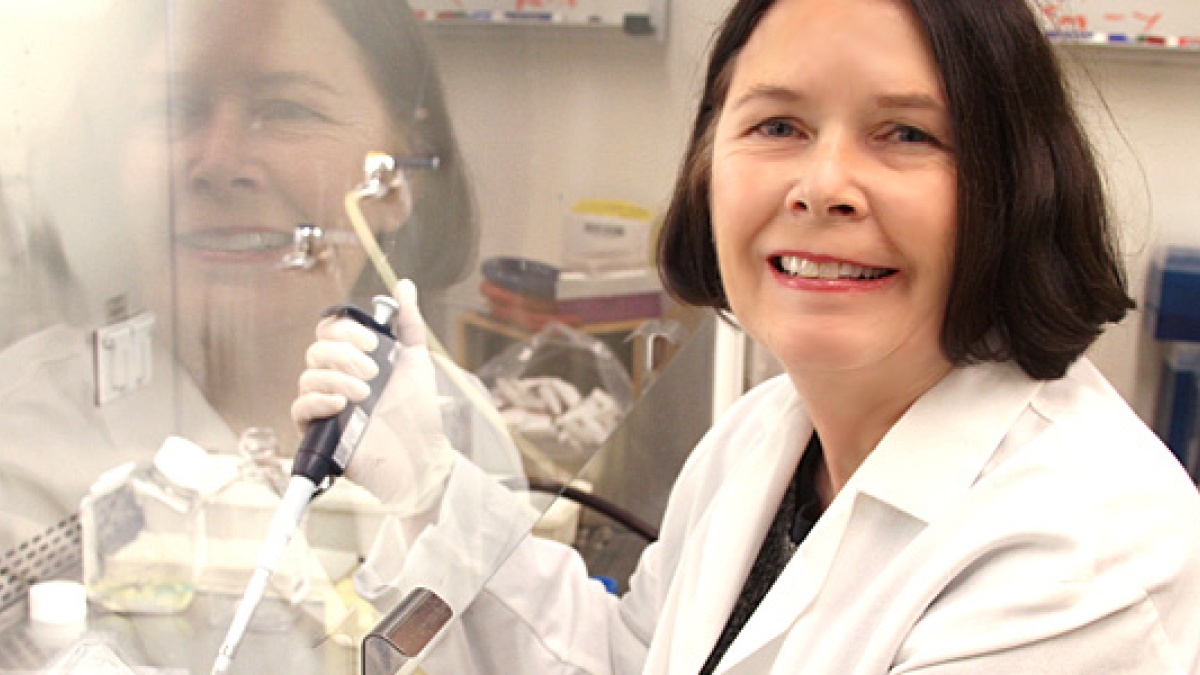Now showing: 3-D movie of a virus in action

Brenda Hogue is a virologist at the Biodesign Institute's Center for Applied Structural Discovery and the Center for Immunotherapy, Vaccines and Virotherapy. She is also professor in the School of Life Sciences.
A research collaboration led by the University of Wisconsin-Milwaukee has for the first time created a three-dimensional movie showing a virus preparing to infect a healthy cell.
The work — done in collaboration with Professor Brenda Hogue, a virologist at Arizona State University’s Biodesign Institute, and Andrew Aquila and his colleagues at the Linear Coherent Light Source at SLAC National Laboratory — has been published in the journal Nature Methods.
The research promises to help advance our understanding of changes that viruses undergo during infection. This could lead to better therapeutic treatments and prevention of viral diseases when applied to studies of viruses that infect humans and other hosts.
The feat was made possible by UWM physicists, who developed a new generation of powerful algorithms to reconstruct sequential images from a large collection of unsorted, noisy data.
Using the brightest and fastest imaging equipment available — an X-ray Free Electron Laser (XFEL) at the Stanford Linear Accelerator Center (SLAC) in California — an international team of researchers, as part of the Single Particle Initiative, collected millions of individual “snapshots” of a virus in unknown orientations and states.
“In the past, scientists have tried to infer what’s happening in a molecular-scale biological process by looking at a still photo at the start and a still photo at the end of a process,” said Abbas Ourmazd, UWM distinguished professor. “But you then don’t know what happens in between. With this method, we are in a position to watch biological machines perform their functions.”
By combining concepts from machine learning, differential geometry, general relativity, graph theory and diffraction physics, the researchers created an algorithm able to reconstruct sequential images.
“To replicate, viruses infect host cells and release their genomic nucleic acid (DNA or RNA) and effectively hijack the cell’s machinery to fabricate multiple new copies of the parental virus,” Hogue said. “Progeny viruses are released which can then infect new cells or hosts. During these processes viruses undergo conformational changes. Our results provide a new approach to understanding the changes that viruses undergo during infection. We expect that in time XFELs will complement the current outstanding capabilities of cryo-electron microscopy, which combined, will provide powerful approaches to insight about the dynamic nature of viruses.”
The researchers’ results show the virus re-arranging its genomic content and forming a tubular structure to release its DNA into a cell, steps that are known to occur during infection by related viruses.
Most viruses are too small to be photographed by light. The XFEL’s intense X-ray flashes produce “snapshots” of particles at the nanoscale through diffraction. The X-rays hit the particle and scatter in a pattern that provides the data for mathematical reconstruction.
More than five years ago, UWM senior researcher Ahmad Hosseinizadeh, a co-author on the paper, began working on the algorithm needed to turn noisy XFEL snapshots into still 3D images. From there, progress was enabled by collaborative work by scientists from different disciplines, said Peter Schwander, a UWM associate professor.
“People didn’t think it could be done,” Schwander said.
Other UWM researchers who are co-authors on the paper include Jeremy Copperman, Ghoncheh Mashayekhi, Russell Fung, Ali Dashti, Reyhaneh Sepehr and Professor Marius Schmidt.
This work was done as part of UWM and ASU involvement in the Science and Technology Center “Biology with X-ray Lasers,” which is funded by the National Science Foundation. Its mission is to use the XFEL to watch biomolecular machines at work, understand how they support life, and provide training and new tools to the scientific community.
Brilliant flashes of light from an X-ray free electron laser, or XFEL, were used to image the virus PR772 with impressive clarity. The brief pulses of laser light strike the crystalized virus, producing a series of diffraction patterns, which are reassembled to construct an image. Many such images were then combined to produce a movie revealing the subtle dynamics of the virus as it infects a cell.
More Science and technology

Cracking the code of online computer science clubs
Experts believe that involvement in college clubs and organizations increases student retention and helps learners build valuable…
Consortium for Science, Policy & Outcomes celebrates 25 years
For Arizona State University's Consortium for Science, Policy & Outcomes (CSPO), recognizing the past is just as important as…

Hacking satellites to fix our oceans and shoot for the stars
By Preesha KumarFrom memory foam mattresses to the camera and GPS navigation on our phones, technology that was developed for…

